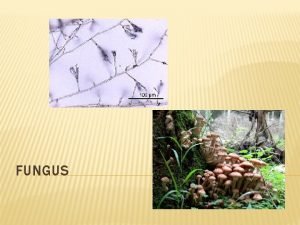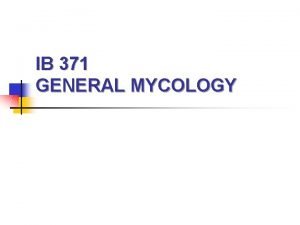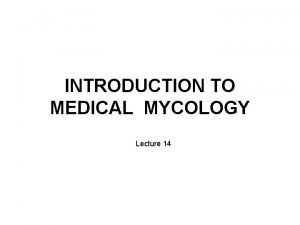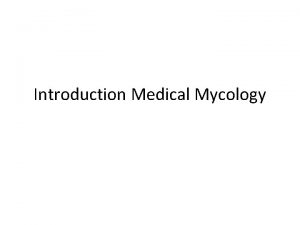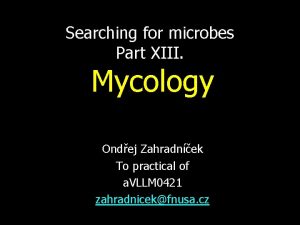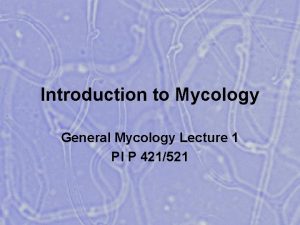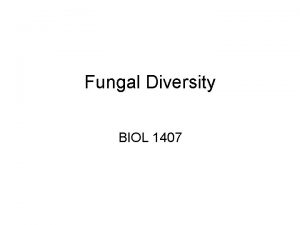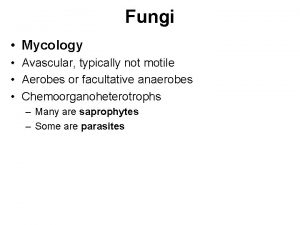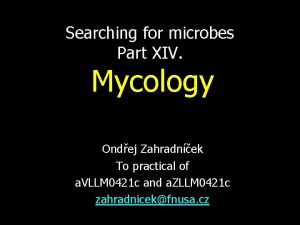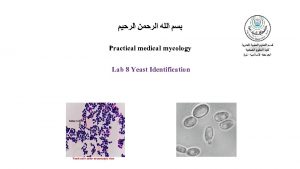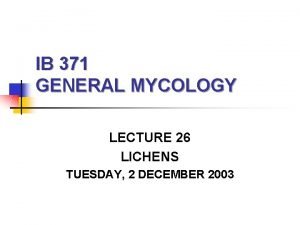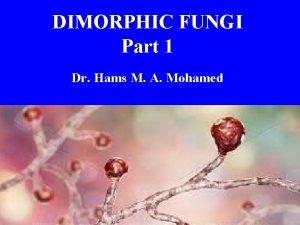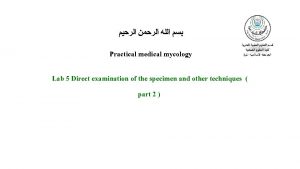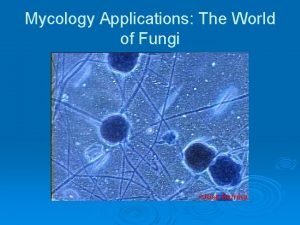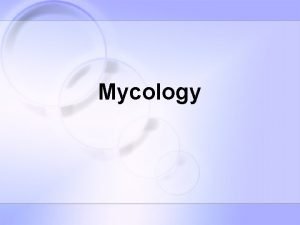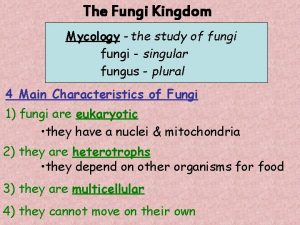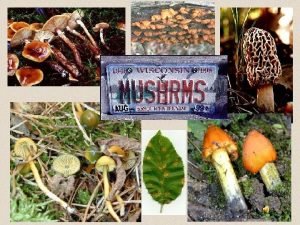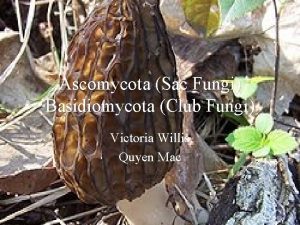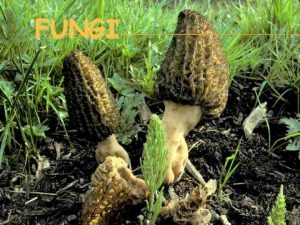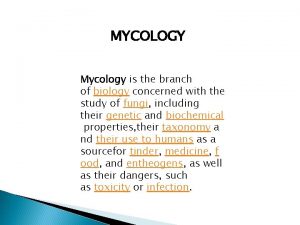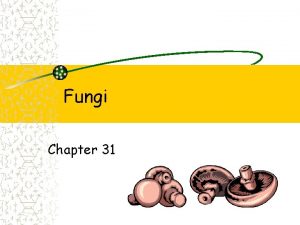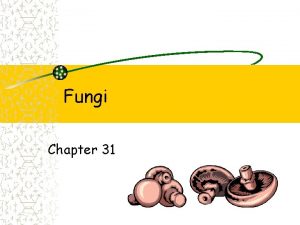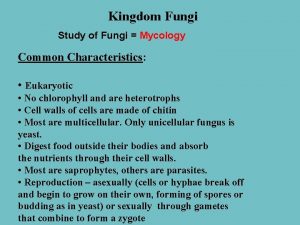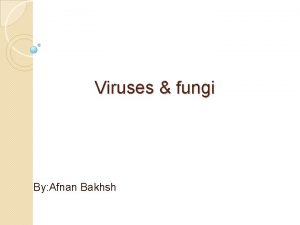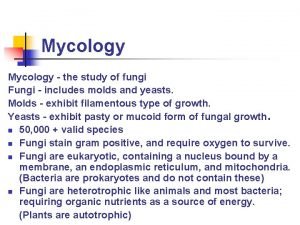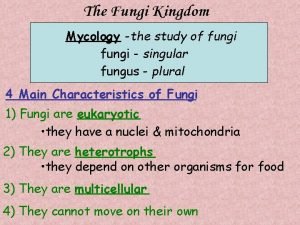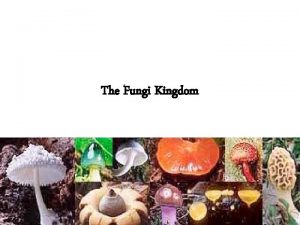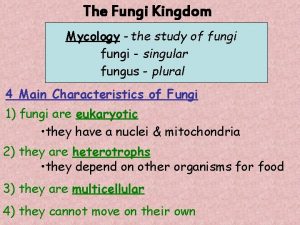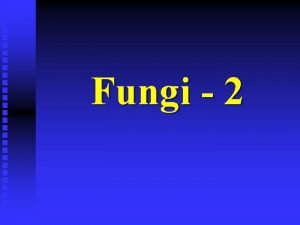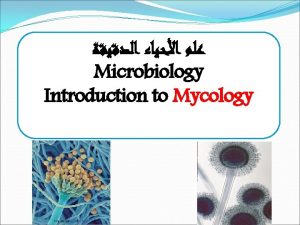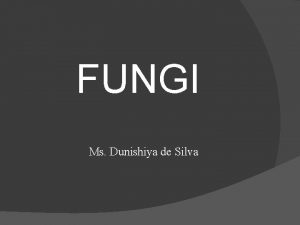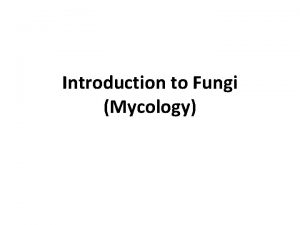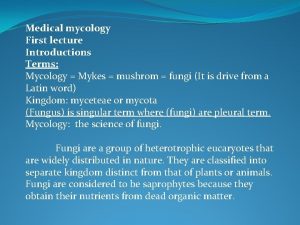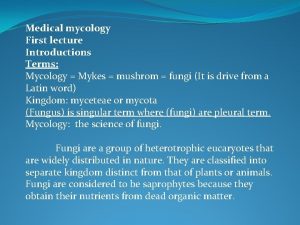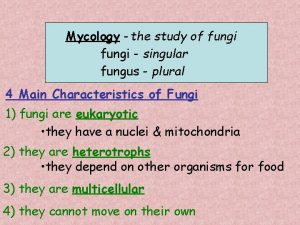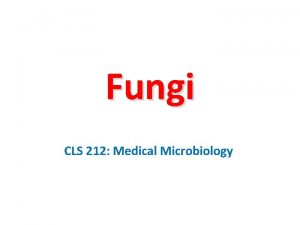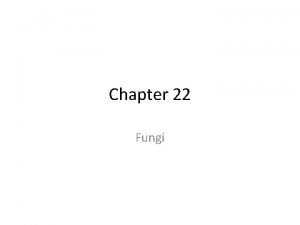Fungi Mycology The study of fungi Aidhm 1























































- Slides: 55

Fungi Mycology: The study of fungi

Aidhm 1. Define the terms: saprophytic & parasitic 2. Explain nutrition in fungi.

http: //www. youtube. com/watch? v=5_rpr. Va-RY 4 Starter sheet

Can you list out any features of fungi (use page 251) • They do not make their own food • They are mostly multi-cellular • They are made up of threads called hyphae • Hyphae combine in masses to form a mycelium • Their walls are made of a carbohydrate called chitin • They have mitochondria. • They store glycogen instead of starch

Nutrition • All fungi are heterotrophs Fungi are either: • Parasitic (used to control numbers of organisms in nature) • Saprophytic (used to recycle and decompose in nature)

Saprophytic fungi • Most fungi are saprophytic: obtain nutrients from dead material • As they digest it minerals are released and recycled • E. g. mushrooms and moulds

Parasitic Fungi • Parasitic: absorb their food from live hosts • E. g. athlete’s foot • Obligate parasites – live on live hosts but do not normally kill them • Facultative parasites – May kill the host and feed on the remains

• Some fungi e. g. form symbiotic relationships with other organisms • A lichen is an organism which is a combination of a fungus and an alga

Can you…. 1. Define the terms: saprophytic & parasitic 2. Explain nutrition in fungi.

Learning Objectives 1. Mention that there are Edible and Poisonous fungi 2. Identify and state functions for the following structures: rhizoid, sporangium, gametangium, zygospore.

Edible and poisonous fungi • Some fungi are edible, but many are poisonous if eaten • Edibile: field mushrooms, truffles • Poisonous: Death cap fungi, the destroying angel

Some key words • A Haploid cell has one set of chromosomes, ie n=23 • A Diploid has two sets of chromosomes, 2 n=46 • Mitosis is where a nucleus divides into 2 nuclei • Meoisis is where a nucleus divides into 4 nuclei

Rhizopus

Rhizopus growing on agar

Structure of Rhizopus

Consists of threadlike structures called Hyphae Hypha

Rhizopus • Saprophytic • Composed of hyphae and mycellium – Hyphae: Thread like structures (not divided into separate cells- aseptate). Digest and absorb substrate on which they grow. – Mycelium: mass of hyphae • Rhizoids: hyphae that grow into substrate. Penetrate, digest and absorb the food source. Secrete enzymes to break down food. • Stolons: horizontal hyphae which allow Rhizopus to spread sideways and find food. • Sporangiophores: Hold sporangium • Sporangium: produce spores • Columella: Base of sporangium. Feeds spores • Apophysis: swollen area of columella

Structure of Rhizopus

Sporangium Spores Columella: swelling below sporangium (feeds spores) Apophysis: wall at base of sporangium Sporangiophore


Complete in your copy

Can you…. 1. Mention that there are Edible and Poisonous fungi 2. Identify and state functions for the following structures: rhizoid, sporangium, gametangium, zygospore.

Learning Objectives 1. State the structure & life cycle of Rhizopus

Life cycle of Rhizopus

Asexual reproduction • Sporangiophores grow up from the substrate after a number of days • Cells within the sporangium divide by mitosis to produce haploid cells • These cells develop a resistant wall. These are spores.

Asexual reproduction • Spores dispersed by wind. If they land on suitable substrate they germinate into a new hypha and mycelium.


http: //bcs. whfreeman. com/thelife wire 8 e/content/cat_010/30040. h tml

Sexual reproduction 1. Sexual reproduction in Rhizopus can only occur between a plus and a minus strain. + Strain - Strain

Sexual reproduction 2. Hyphae from opposite strains grow close together. Swellings grow on both strains and touch each other. + Strain - Strain

Sexual reproduction • 3. Nuclei from both hyphae move into these swellings which are now called progametangia. + Strain - Strain

Sexual reproduction 4. Cross-walls form to produce gametangia. + Strain - Strain

Sexual reproduction 5. The walls of the gametangia dissolve and a number of fertilisations take place producing diploid zygote nuclei. + Strain - Strain

Sexual reproduction 6. A tough walled, zygospore forms around these nuclei. 7. When conditions are suitable the zygospore germinates by meiosis. + Strain - Strain

Sexual reproduction 8. A hypha grows out of the zygospore and produces a sporangium at the tip. 9. The sporangium opens releasing many haploid spores which grow into new individuals.

Remember • Gametangium: used for sexual reproduction • Zygospore: for dispersal


Put the pictures 1 -4 in order and label parts A and B 1 2 3 4

Can you…. 1. State the structure & life cycle of Rhizopus

Learning Objectives 1. Outline the structure & reproduction of Yeast 2. Name 2 Beneficial & 2 Harmful fungi

Yeast

Structure of yeast: Single celled • Cell wall: made of chitin • Lots of storage granules – cytoplasm appears granular.

Can you label this

Reproduction by budding in Yeast 1. A small bubble grows out from the cell wall and fills with cytoplasm 2. Divides by mitosis 3. One nucleus moves into bud 4. Bud pinches off mother cell

Sometimes this can happen….

Budding

Budding

Economic importance of fungi Beneficial fungi • Yeasts: production of alcohol (brewing) in anaerobic (no oxygen) conditions • Fungi: used as a source of food e. g. mushroom

Economic importance of fungi Harmful fungi • Fungi: cause crop disease e. g. potato blight • Fungi: food spoilage e. g. rhizopus grows on bread

Practical Activities: Investigate the growth of leaf yeasts using agar plates and controls Aseptic: Exclude unwanted organisms Sterile: All microorganisms destroyed.

Result: yeast colonies seen as pink growths

Complete in your copy


Can you…. 1. Outline the structure & reproduction of Yeast 2. Name 2 Beneficial & 2 Harmful fungi

Learning Objectives • • Define the terms: saprophytic & parasitic Explain nutrition in fungi. Mention that there are Edible and Poisonous fungi State the structure & life cycle of Rhizopus Identify and state functions for the following structures: rhizoid, sporangium, gametangium, zygospore. Outline the structure & reproduction of Yeast Name 2 Beneficial & 2 Harmful fungi
 White piedra
White piedra Lichen as food
Lichen as food Scotch tape preparation for fungi
Scotch tape preparation for fungi Capsulated fungi examples
Capsulated fungi examples Mycology
Mycology Mycology lecture
Mycology lecture Ascomycota
Ascomycota Mycology
Mycology Mycology
Mycology Industrial mycology
Industrial mycology Candida albicans germ tube test
Candida albicans germ tube test Mycology lecture
Mycology lecture Blastomyces dermatitidis
Blastomyces dermatitidis Tease mount method
Tease mount method Mycology
Mycology Mycology test
Mycology test S i n g u l a r
S i n g u l a r Medical mycology ppt
Medical mycology ppt Fungi
Fungi Sac fungi definition
Sac fungi definition Club fungi are morels truffles bracket fungi yeast
Club fungi are morels truffles bracket fungi yeast Branch of biology concerned with the study of fungi
Branch of biology concerned with the study of fungi Dot
Dot Vẽ hình chiếu đứng bằng cạnh của vật thể
Vẽ hình chiếu đứng bằng cạnh của vật thể Biện pháp chống mỏi cơ
Biện pháp chống mỏi cơ Phản ứng thế ankan
Phản ứng thế ankan Chó sói
Chó sói Thiếu nhi thế giới liên hoan
Thiếu nhi thế giới liên hoan Sự nuôi và dạy con của hổ
Sự nuôi và dạy con của hổ điện thế nghỉ
điện thế nghỉ Một số thể thơ truyền thống
Một số thể thơ truyền thống Trời xanh đây là của chúng ta thể thơ
Trời xanh đây là của chúng ta thể thơ Slidetodoc
Slidetodoc Các số nguyên tố
Các số nguyên tố Fecboak
Fecboak đặc điểm cơ thể của người tối cổ
đặc điểm cơ thể của người tối cổ Các châu lục và đại dương trên thế giới
Các châu lục và đại dương trên thế giới Chụp phim tư thế worms-breton
Chụp phim tư thế worms-breton Thế nào là hệ số cao nhất
Thế nào là hệ số cao nhất Hệ hô hấp
Hệ hô hấp ưu thế lai là gì
ưu thế lai là gì Tư thế ngồi viết
Tư thế ngồi viết Cái miệng nó xinh thế
Cái miệng nó xinh thế Cách giải mật thư tọa độ
Cách giải mật thư tọa độ Bổ thể
Bổ thể Tư thế ngồi viết
Tư thế ngồi viết Thẻ vin
Thẻ vin Thể thơ truyền thống
Thể thơ truyền thống Bài hát chúa yêu trần thế alleluia
Bài hát chúa yêu trần thế alleluia Các châu lục và đại dương trên thế giới
Các châu lục và đại dương trên thế giới Từ ngữ thể hiện lòng nhân hậu
Từ ngữ thể hiện lòng nhân hậu Sự nuôi và dạy con của hổ
Sự nuôi và dạy con của hổ Diễn thế sinh thái là
Diễn thế sinh thái là Vẽ hình chiếu vuông góc của vật thể sau
Vẽ hình chiếu vuông góc của vật thể sau V. c c
V. c c Phép trừ bù
Phép trừ bù
